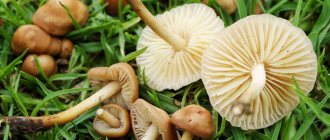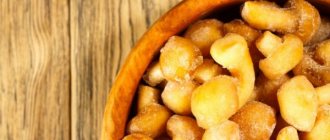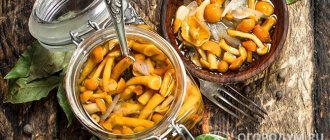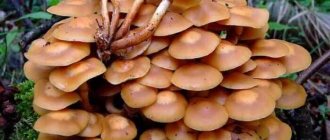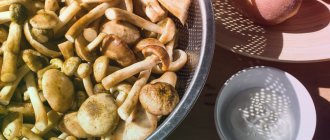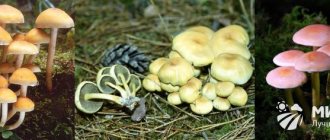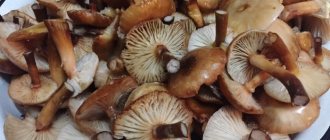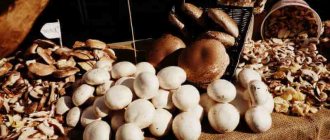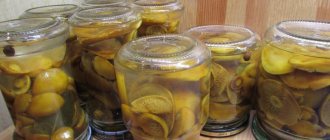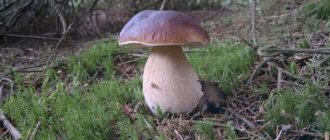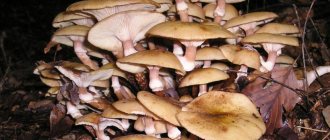Mushrooms
0
3192
Article rating
Kira Stoletova
Honey mushrooms are outwardly inconspicuous, unpretentious mushrooms, but they have excellent taste and are universal in use. They are often grown at home. The growth time of honey mushrooms is short and depends on organized climatic conditions.
How long does honey mushrooms take to grow?
Features of growing honey mushrooms
In nature, honey mushrooms grow in large groups on fallen trees and stumps.
- These are hemp mushrooms that actively reproduce on moistened wood of deciduous trees. They do not germinate on rotten plants. This growing method is also practiced at home. Mycelium grows with proper care in a greenhouse, as well as in glass jars.
- If there are freshly cut trees in the garden plot, it is better to choose the main method of cultivation and not risk future honey mushrooms. If not, sprouting mycelium in a jar will do. The body of the fruit or a piece of wood where they sprouted earlier is used as planting material.
- The time for growing mycelium on stumps (or with other methods of maintenance) depends on weather conditions. Usually they go to the forest to pick mushrooms after the rain, expecting to get a rich harvest. In artificially organized conditions, climate also plays an important role.
The more precise and better the growing conditions are, the faster the growth rate will be. The average readiness of mycelium for harvesting is 7-8 days.
What trees do edible honey mushrooms grow on and what do they look like?
Edible honey mushrooms are divided into spring, summer, autumn and winter types. Let us note specifically on which trees edible honey mushrooms grow. Spring and summer honey mushrooms are distributed mainly on deciduous trees; trunks with damaged and rotten wood are especially preferred. And in mountainous areas, summer honey mushrooms are found on spruce trees and spruce stumps. Honey mushrooms growing on coniferous trees have a bitter taste and dark color, although this does not in any way affect their nutritional value. Summer honey mushrooms have a leg up to 7 cm high and up to 1 cm in diameter. The lower part of the leg is covered with dark small scales. The “skirt” around the leg is narrow with some abrupt edges.
In the deciduous forests of the temperate zone of Russia, summer honey mushrooms can be collected from April to August. In a favorable climate, this species can bear fruit without interruption. Since summer mushrooms have false doubles, experienced mushroom pickers advise collecting them only on the remains of deciduous trees, or better yet, exclusively on stumps left after cutting down birches.
Dependence of mycelial growth on air temperature
They often rely on air temperature. Reproduction of mycelium on stump begins already at a temperature of 3°C-4°C (spores of winter, autumn and spring honey mushrooms germinate). The mushroom grows under such conditions for up to 30 days. The rate of germination changes with fluctuations in night and day temperatures.
A favorable indicator for active mycelium growth is 16°C-26°C. Without temperature changes and high humidity, summer and autumn varieties of fruiting bodies are able to grow and complete the period of active growth in just 8-9 days. If the indicator is higher, the germination rate slows down.
When the thermometer exceeds 30°C, the honey fungus quickly deteriorates, especially if there is drought during its development.
Growth of honey mushrooms in the forest
Temperature is important for mushroom growth
Meadow honey mushrooms (they are also called wild honey mushrooms) sprout on stumps; for active growth, they need a temperature of 20°C-23°C (summer) and 10°C-12°C (autumn and spring). High humidity of wood and air is also important for rapid ripening of fruiting bodies. Both autumn and spring and summer mushrooms require a combination of heat and moisture for rapid development.
Favorable humidity indicator is 50-65%. In just one day, an increase of 2-2.5 cm is observed. In the following days, only the cap develops. You can go for mushrooms 3-4 days after the rain.
If the parameters of heat and moisture are maintained at home, the edible fruit will germinate on the stump up to 4 times a month.
How to distinguish false honey mushrooms from edible ones
False honey mushrooms grow just like real ones, in colonies on stumps and old trees. At first glance, they can easily be confused with edible fruiting bodies.
However, there are quite a few signs that can help distinguish a false honey fungus from an edible one:
- An adult Armillaria has a rim on its stalk, which is a remnant of the protective film that covered the plates of young fungi.
- False honey mushrooms have a much brighter color (yellow, gray-olive or brick-red) than true ones.
- True Armillaria has cream or slightly brownish plates at the bottom of the cap, while false Armillaria has yellowish-gray plates.
- Edible fruiting bodies have a pleasant smell, while false ones smell unpleasant to humans.
Germination rate of autumn mushrooms
Autumn mushrooms, collected in September and early October, are the most popular among mushroom pickers. It's the start of the rainy season, but the weather is still warm outside. This period is considered the most productive time for collecting mushrooms.
In autumn, honey mushrooms grow most quickly. From the end of August to mid-October, the mycelium grows in just 8 days. In the event of heavy rain, it takes even less time to grow. The fruiting body is suitable for cutting already on the 4-5th day.
Autumn honey mushrooms have different growth rates, depending on the condition of the wood. On old and rotten wood, the mycelium grows faster because it absorbs moisture more easily. In just a day, their number often doubles, and a new, emerging mushroom, after 24 hours will have a leg 4-5 cm long and a cap with a diameter of 2-2.5 cm. The maximum growth of this mushroom reaches 14 cm at the cap size is 8-9 cm. If the mushroom exceeds this size, most likely it is false.
Description of honey mushrooms
Young fruiting bodies have convex caps with small scales. As the cap grows, it becomes flat and wide, and the scales most often disappear. The color of the cap varies from light honey to dark olive. Size 3–17 cm. The leg grows 7–12 cm in height and usually 1–2 cm in girth. Thin and light at the top, widens downward and acquires a dark color. Covered with a coating in the form of flakes.
Young fruiting bodies have a “skirt” on the stem, which disappears over time . Young fruiting bodies have denser pulp. In mature mushrooms, the stem acquires a tough, fibrous texture. The plates, hidden under very young caps, straighten and darken with growth.
Rain and other factors affecting mushroom growth
The fact that mushrooms grow rapidly after rain is not a completely true statement. Rain alone cannot cause massive mushroom growth. A lot of other factors also influence the growth rate. The most significant of them are the following:
- Temperature.
- Humidity.
- Lighting.
- Chemical composition of the soil.
- Harmful insects.
The humidity factor involves two components: air humidity and soil moisture. Each species has its own preferences in this regard, but, if we take the statistical average, the optimal humidity level for good growth is considered to be 70%. Soil moisture should correspond to air humidity. If a prolonged drought occurs after heavy rains, the mushrooms will grow slowly because the moisture in the soil will evaporate quickly. Thus, the soil will become dry and the air will become waterlogged, which will upset the balance.
Mushroom growth
Proper lighting plays an important role in active mushroom growth. Many species prefer to grow in sunny meadows or partial shade. If the forest grows too much, they don't have enough light. As a result, they slow down their growth and become deformed, losing their visual appeal.
Most edible mushrooms prefer slightly acidic soil. The only exceptions are a few species that grow well in sandy, limestone or other types of soil. Interventions in the chemical composition of the soil lead not only to growth stagnation, but also to the extinction of entire fungal families.
Indicators of optimal temperature and humidity for mushroom growth
Mycelium with its terrestrial parts are at risk of infection by the larvae of some types of harmful insects. Affected myceliums bear fruit poorly, and the mushrooms are small and grow very slowly. Mechanical damage provokes rot and other serious diseases. Active growth of most mushroom species occurs in the fall. Then the process of mass decay begins.
In the understanding of most, mushrooms are fruiting bodies, most often consisting of a stem and a cap. In fact, it is only the terrestrial part of a complex organism. The mycelium, or mushroom place, is located under a layer of soil, growing systematically throughout its life. The growth of mycelium is not affected by weather conditions; it grows equally both after heavy rain and during severe frosts.
The best time to collect different types of mushrooms is in summer and autumn
The first mushrooms appear in April, but May is considered the official opening month of the mushroom season. Usually mushroom hunting lasts until October inclusive. But if weather conditions are favorable, new mushrooms grow in November and even in December.
It is better to harvest according to the mushroom calendar. Based on his data, the mushroom picker is less likely to run into an inedible double. The following table details the entire growth period of certain edible species.
| Species name | May | June | July | August | September | October |
| Porcini | + | + | + | + | + | |
| Valuy | + | + | + | + | + | |
| Volnushka | + | + | + | + | + | |
| Volnushka white (Belyanka) | + | + | ||||
| Gorkushka | + | + | + | + | ||
| Gruzd | + | + | + | + | ||
| Raincoat | + | + | + | + | + | |
| Greenfinch | + | + | + | |||
| Kozlyak | + | + | + | + | ||
| Cap | + | + | + | + | ||
| Chanterelle | + | + | + | + | + | |
| Oiler | + | + | + | + | + | |
| Mosswort | + | + | + | + | ||
| Honey fungus | + | + | + | |||
| boletus | + | + | + | + | + | + |
| Boletus | + | + | + | + | ||
| Ryzhik | + | + | + | + | ||
| Ryadovka | + | + | + | |||
| Serushka | + | + | + | + | ||
| Violin | + | + | + | |||
| Morel | + | |||||
| Russula | + | + | + | + | + | + |
| Champignon | + | + | + | + |
The first harvest is much smaller than the harvest collected during the period of active mushroom growth. The following provides data on the peak growth activity of certain edible species.
| Species name | May | June | July | August | September | October |
| Porcini | + | + | ||||
| Valuy | + | + | ||||
| Volnushka | + | |||||
| Volnushka white (Belyanka) | + | |||||
| Gorkushka | + | + | + | |||
| Gruzd | + | + | ||||
| Raincoat | + | + | ||||
| Greenfinch | + | + | ||||
| Kozlyak | + | + | + | |||
| Cap | + | + | ||||
| Chanterelle | + | + | ||||
| Oiler | + | + | ||||
| Mosswort | + | |||||
| Honey fungus | + | + | ||||
| boletus | + | + | ||||
| Boletus | + | + | + | |||
| Ryzhik | + | + | ||||
| Ryadovka | + | |||||
| Serushka | + | + | ||||
| Violin | + | + | ||||
| Morel | + | |||||
| Russula | + | + | + | + | ||
| Champignon | + | + | + | + |
An interesting fact is that during Indian summer you can find varieties from all seasons of the year. And after it, mushroom pickers can only collect the remains of the autumn harvest and winter honey mushrooms.
Duration of the mushroom period for different species
In warm, sunny weather, many new mushrooms appear in the forest after a good rain. In order to determine the mushroom age, it is enough to simply know the duration of the growth period of certain species.
The most common types of Russia have the following growth periods:
- porcini mushrooms reach large sizes already 2-3 days after warm rain;
Most species grow in 3 to 5 days. Full ripening usually occurs on the 10th day. It is noteworthy that fungal organisms grow equally actively both during the day and at night, without wasting time on rest. As autumn approaches, growth slows down. This is due to a decrease in air temperature.
Rules and gathering places after rain
Experienced mushroom pickers always follow the basic rules of mushroom picking:
- Do not add suspicious fruits to your basket.
- Collect only well-known species, otherwise there is a risk of confusing edible mushrooms with their poisonous counterparts.
- Cut off the mushroom units with a knife, and do not break them with your hands, so as not to damage the mycelium.
- Do not harvest near roadways or industrial centers.
- Observe the subtleties of the technology for collecting and preparing certain types.
Each species has its own habitat preferences. The following table summarizes the distribution locations of the most famous types of mushrooms.
| Species name | Places of distribution |
| White | Old deciduous and coniferous forests, mainly under oaks |
| Valuy | Deciduous plantings |
| Volnushka | Coniferous plantations, deciduous forests |
| Belyanka | Coniferous plantations, deciduous forests |
| Gorkushka | Sunny forest glades |
| Gruzd | Mixed forests |
| Raincoat | Floodplain forests, glades, park areas |
| Greenfinch | Mixed type of forest plantations |
| Kozlyak | Mixed plantings |
| Cap | Sunny forest glades |
| Chanterelle | Deciduous and coniferous forest plantations |
| Oiler | Coniferous forest plantations |
| Mosswort | Deciduous and coniferous forests |
| Honey fungus | Dead deciduous trees |
| boletus | Deciduous forests, mainly under birch trees |
| Boletus | Deciduous plantations, mainly under aspen trees |
| Ryzhik | Mixed type of forest plantations |
| Ryadovka | Forest edges, bushes, parks and squares |
| Serushka | Floodplain forests |
| Violin | Mixed plantings |
| Morel | Floodplain forests |
| Russula | Coniferous and deciduous forests |
| Champignon | Shrubs, roadside plantings |
You can harvest mushrooms from May until the first frost.
Any avid mushroom picker will never miss the ripening season of such common forest gifts as honey mushrooms. The culture is widely known both in our country and abroad, and during the harvesting period of fruiting bodies, a huge number of collectors go to the forest. The popularity of the delicacy is explained by its bright taste and wide range of “uses” - mushrooms are an excellent independent dish, and can also be added to salads, soups, sauces or other culinary masterpieces.
To ensure that a foray into the forest does not become in vain, it is important to know at what time, under what conditions, where and how much honey mushrooms grow. Let's consider this issue in more detail, determining how to choose the best time to harvest the forest crop we are considering.
What forests do they grow in?
It is important to understand in which forests edible autumn honey mushrooms grow. These fungi are parasites. They grow on dead wood. They are almost never found on healthy trees. Thus, the most fungal forests are old deciduous, coniferous and mixed forests.
Honey mushrooms are extremely common in nature. The more dead trees in the forest, the more active myceliums, since honey mushrooms grow on old stumps. Clearings are the best places to look for autumn mushrooms in the forest.
They often appear on logs of the following types of trees:
- birch;
- alder;
- aspen;
- elm.
On these trees, the growth of edible autumn honey mushrooms begins within 2-3 years. At the same time, a fallen oak or pine tree can become the basis for a fungus only after 8-10 years. You need to regularly go to new clearings to find out in advance where this mushroom appeared.
Important! Autumn honey mushrooms love to grow in lowlands, because... Humidity is high in these areas. Mushrooms grow better in loose soils saturated with oxygen.
They rarely appear on living but severely damaged trees. In addition, you can look for these mushrooms near young and weakened birch, pine and oak trees. Fungi can often cause the death of these trees.
Where and how honey mushrooms grow
Even a novice mushroom picker knows that the ideal place for the development of mushroom mycelium is fallen deciduous trees, dead wood and old stumps. It is on the listed surfaces that spreading colonies of the crop are most often found. However, it often happens that, coming to the forest thicket, a collector comes across overgrown fruiting bodies, the so-called burdocks, the taste and tenderness of whose pulp leave much to be desired. The conclusion is simple - the time for quiet hunting was chosen incorrectly.
In order to determine the ideal time for harvesting, it is necessary to rely on climate, weather conditions and minimal knowledge about the crop’s habitat:
- As for the summer representatives of the family, the appearance of fruiting bodies, as well as their abundant growth, are observed at an air temperature of 14-25 degrees Celsius.
- Winter, spring and autumn colonies grow when the positive mark reaches 3-5 degrees.
The cap is covered with scales.
What weather is needed for mushroom growth: optimal temperature
Everyone knows that honey mushrooms grow in large colonies, settling on rotten stumps and fallen trees. To meet such a friendly “family” on your way is real luck. However, it happens that when we come to the forest, we come across a meager harvest of overgrown honey mushrooms. Most likely, this is due to unsuitable weather conditions, as well as the choice of the wrong time to go for fruiting bodies. In this case, you need to know what kind of weather is needed for honey mushrooms to grow. Such information will help you determine as accurately as possible when you should go on a “silent hunt.”
What temperature is considered optimal for the growth of honey mushrooms in the forest? It must be said that temperature is one of the most important factors affecting the growth of fruiting bodies. Thus, for most mushrooms, including some types of honey mushrooms, the average temperature for abundant growth and fruiting is +15-26°C. However, spores of autumn, spring and winter honey mushrooms begin to grow already at a temperature of +3-5°C. But high air temperatures have a negative effect on the growth of fruiting bodies. So, at +30°C and above, the growth process stops completely, and if there is also drought, the mushrooms begin to dry out and deteriorate. In addition, sharp and strong fluctuations in day and night temperatures also greatly slow down the growth of honey mushrooms.
Favorable weather conditions for growth
Lack of precipitation, drought and high temperatures (over 25 degrees Celsius) have a detrimental effect on the mushroom mycelium - the fruits may not begin to grow at all, or they quickly die, losing moisture and collapsing from the inside.
Another unfavorable factor is sudden temperature changes (cold at night, scorching hot during the day). If fluctuations exceed the range of 10 degrees per day, the growth of honey mushrooms practically stops.
Excessive precipitation with frosts also does not contribute to a good harvest. If there is a heavy downpour once or twice in a few days, it’s time to run and check the “prey”. Has it been raining for weeks? Honey mushrooms will grow, but most likely they will be wormy and watery. In addition, mycelium requires oxygen, which does not penetrate well into the soil during droughts or floods.
How long do honey mushrooms grow, if we talk about the rate of maturation of one stream?
As we found out earlier, the growth process of the fruiting bodies of the crop we are considering depends on natural factors. Based on this, it is impossible to determine the exact period of ripening of the mushroom crop.
In a favorable climate, the process takes from 36 to 72 hours, and the cap continues to develop for several days after the growth of the stem has stopped. During the day, the fruit increases by about 2 cm, but only when the mycelium is not affected by insects and “inappropriate” weather.
The overall lifespan of the fungus is short - 10 days from the moment the delicacy “breaks through” from the upper layers of the substrate. It is recommended to harvest in the first 4-7 days; after this period, the attractive caps turn into spreading burdocks, and the pulp begins to dry out, becoming hard and tasteless.
Honey fungus
Another fake honey fungus, which is directly related to non-rotting mushrooms. It is named honey mushroom only for its partial external resemblance to true honey mushrooms, but otherwise it is not at all similar to them.
Fresh fruiting bodies of the meadow honey fungus are usually small: the cap is on average 5 cm in diameter, the stem is 6 cm long, occasionally there are specimens with an 8-centimeter cap and a stem up to 10 cm. The color is ocher-brownish, depending on the weather: in the heat it is paler than at high humidity (in this case the cap also becomes sticky).
This mushroom avoids forests, preferring open spaces overgrown with grass, especially those where cows and other herbivores often graze, and the ground is well fertilized. The honey fungus is a typical saprophyte that feeds on organic debris.
We invite you to familiarize yourself with: First fertilizing of tomatoes, timing and fertilizers
It bears fruit almost throughout the warm season - from the end of May to the end of October.
Growth of autumn representatives after the first cutting
Most mushroom pickers prefer to “hunt” autumn mushrooms because of their attractive appearance, bright taste and pleasant aroma. It is believed that this particular species is an ideal “base” for snacks, as well as for winter preparations.
Autumn honey mushrooms grow from the beginning of September to the end of October, with the first cold snap and the arrival of the rainy season (the period may vary for different regions). At the same time, the growth of the variety is faster than all other members of the family - the mushrooms become adults within 5-7 days.
Experienced gatherers prefer to cut the crop already on the third or fourth day of growth, at the moment when the fruit resembles a neat, beautiful carnation. If you went exploring and came across a stump or tree, on the surface of which tiny honey mushrooms have just begun to emerge, return to the place of discovery after 24-36 hours, you will be able to collect the perfect delicacy.
After waiting a few days, check the productive area again; most likely the mycelium has not stopped developing, which means new fruiting bodies have appeared in the same place.
When honey mushrooms are collected
Boletus mushrooms, especially young and strong ones, are in no way inferior to white ones - even boiled, dried, or fried. And if they go in layers, then you can collect more than one bucket of them in a relatively small forest.
According to popular belief, the first boletuses appear when the mountain ash blooms, and then they do not leave forest glades and birch groves all summer. Unless, of course, the summer was too hot and dry. But the summer boletus has one drawback - the worm really loves this tasty mushroom. So the mushroom picker has to reluctantly throw away one mushroom after another.
In autumn, boletus flowers are clean and strong. And besides, their special appearance appears - with a thick stem and a dark cap, the taste is practically no different from the white one. Finding it, however, is not easy in the fallen leaves. But if you come across one, then you can find a dozen more around it.
At what temperature do mushrooms grow in autumn (boletus mushrooms)? Their temperature regime is almost the same as that of whites. For boletus, 10–12 degrees Celsius is quite enough, only these mushrooms love wetter weather, not prolonged rains, but thick autumn fogs. And if the autumn is dry, then boletus mushrooms should be looked for in damp places, in lowlands and even in a swamp.
A good mushroom picker knows at what temperature mushrooms grow. In the fall, in the forest, he will quickly fill a basket, or even take out a bag - don’t leave boletus and boletus, aspen and boletus, milk mushrooms and capillaries under the fir trees and birches! And if honey mushrooms attack, there may not be enough packages.
There may be three layers of honey mushrooms per season
The harvest season begins in the last days of August and covers the entire first winter month, but mass fruiting of mushrooms occurs in mid-September, especially if the air temperature does not drop below 10°C-15°C.
In many regions, honey fungus appears in 2-3 layers, each lasting 15-20 days.
For different species, honey mushrooms are collected at different times:
- autumn ones begin to be collected from August until November,
- winter varieties bear fruit throughout the fall and catch the winter with the first frosts until December; some winter species in warm climate regions begin to bear fruit only in October and remain under snow until March, but their growth stops when the temperature drops below 0°C,
- spring meadows appear already in March-May, extending the fruiting season until June-July,
- The fruiting period for summer mushrooms lasts from mid-August to the end of October.
The most suitable time of day for collecting honey mushrooms is considered to be early morning, when the mushrooms retain their fresh appearance after the cool of the night, and after collection they will remain resistant to transportation and are stored longer.
In the process of collecting honey mushrooms, it is recommended to adhere to methods that allow you to preserve the mycelium from mechanical damage. This will make it possible to return to this place next year. The mushrooms are not pulled out, but cut with a sharp knife or removed from the mycelium by twisting, turning around an axis.
Among the entire family, only young specimens are chosen, leaving behind the toxins that have accumulated over a long time. To spread the spores of overgrown and rotten mushrooms, they are hung on branches by their caps.
Autumn honey fungus. How, when and where to collect!
How and where to collect milk mushrooms, boletus, honey mushrooms
How long do honey mushrooms grow after heavy rain?
Beginning fans of forest gifts often hear that mushrooms appear after rain, but not everyone knows when exactly this “after” occurs.
It has been scientifically established that the best time to check the mushroom harvest is the second or third day after the last drop of heavenly moisture has fallen to the ground. If the rainfall does not happen, turning into a half-hour “digging”, those whose area is familiar with thick fogs should not despair. Fog is another source of moisture for the natural forest substrate. Plan your outing early in the morning, and most likely you will return home with a basket full of delicious honey mushrooms.
Winter mushrooms
Finally, a few words about no less attractive representatives of the family - winter honey mushrooms.
The ripening period is from early October to early December (for warm climates). The optimal favorable air temperature is 7-10 degrees Celsius, as for the rate of fruit maturation - it is no different from the previously discussed autumn variety. Winter mushrooms are not afraid of cold and frosts; there have often been cases when young mushrooms found themselves under the snow, and with the onset of a thaw they “woke up” and continued to develop, turning into full-fledged, intact, tasty prey.
As you may have noticed, the mushrooms we are considering are very unpretentious, and they also develop in colonies, which greatly simplifies the collection of delicacies.
The information we present will be an excellent guide even for people without extensive collecting experience. Has the rain stopped? Get ready for a quiet hunt.
- Author: Maria Sukhorukikh
Rate this article:
- 5
- 4
- 3
- 2
- 1
(0 votes, average: 0 out of 5)
Share with your friends!
Types of mushrooms
As mentioned above, honey mushrooms are divided into edible and inedible types. Now let's look at each representative separately.
Autumn honey fungus
Autumn honey fungus is a representative of the Physalacriaceae family. It is common in damp forests of the Northern Hemisphere and prefers to be found on the stumps of deciduous trees. In addition, this species can be found as a parasite on some plants, such as potatoes. The cap of this mushroom can reach 17 centimeters in diameter and is colored dark brown.
This is what autumn honey fungus looks like
The entire mushroom is covered with small scales, and its flesh is very dense, with a whitish tint. The leg of the autumn honey fungus has a size of up to 10 centimeters, and its diameter is 10-20 millimeters. The collection season for this species is considered to be summer - the end of September and it can also be found at an average air temperature of about +10 degrees.
Summer honey fungus
The summer honey fungus belongs to the strophariaceae family. It prefers deciduous trees, less often pine trees, and lives in a temperate climate. The cap of this species is very small in diameter - 3-6 centimeters. From birth, the top is semicircular in shape, and over time it loses its convexity and becomes flatter. The color of the cap can vary from brown to dull yellow. Its shade depends on the amount of rainfall. The more moisture, the lighter the shade. The tubercle, which is located in the middle of the cap, is often of a different color - it is lighter than the other zones, and during rain it begins to darken. The mushroom itself does not have scales, and its skin is often covered with a thin layer of mucus. The mushroom stalk grows to a size of 7 centimeters, after which its development stops. It has small dark scales that remain until the “end of life” of the mushroom. This mushroom can be found in early April and until November, but in warm climates, summer honey mushrooms can be collected all year round.
Winter honey fungus
The winter honey fungus belongs to the category of edible mushrooms and is a representative of the family of rowaceae or tricholomaceae. This mushroom is very fond of temperate and northern climate zones and prefers deciduous trees such as poplars, birch and willow. The mushroom cap is 2-10 centimeters in diameter. It is flat, light yellow in color and has thin flesh. The leg is also small – 2–7 centimeters. It is quite dense, with small fibers that retain moisture in the mushroom for a long time. This mushroom is found both in autumn and spring. It bears fruit well in the cold season and can withstand very low temperatures.
Spring honey fungus
The spring honey fungus belongs to the family of non-rotting mushrooms and is found under oaks and pines. The difference from other species is that the spring honey fungus most often grows singly and prefers mixed forests. Its cap can reach 7 centimeters, and its minimum diameter is 10 millimeters. Its shape depends on age - at first it is highly convex, then less convex, and later it becomes completely flat. The color changes according to the same principle - from red-brown to yellow-brown. The hat is attached to a flexible leg, the size of which is 3-9 centimeters. It is relatively smooth and thin, but it is quite difficult to break. The peak growth of spring honey fungus occurs in July. Most often it can be found from late May to early October.
